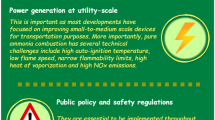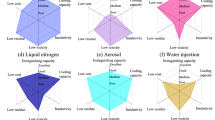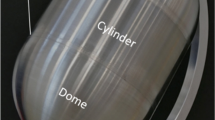Abstract
Pacific Northwest National Laboratory (PNNL) has leveraged focused ion beam capability at their Category II Nuclear Facility to facilitate nuclear materials analysis and experimentation at the micron scale. For this particular study, micron-size specimens of un-irradiated UO2 fuel pellets of various enrichments were prepared and irradiated to a burnup equivalent of 8–3700 MWd/MTU. This represents first of its kind study of used fuel investigations outside of a hot cell facility, dramatically minimizing resource requirements through reduction in scale. Results of this study provide insight into the initial production of noble metal phase particles in used nuclear fuel at extremely low burnup levels.


Similar content being viewed by others
References
Bradbury BT et al (1965) Electron probe micro-analysis of irradiated UO2. J Nucl Mater 17(3):227236
Kleykamp H, Paschoal JO, Pejsa R, Thommler T (1985) Composition and structure of fission product precipitates in irradiated oxide fuels: correlation with phase studies in the Mo–Ru–Rh–Pd and BaO–UO2–ZrO2–MoO2 systems. J Nucl Mater 130:426–433
Pellegrini KL et al (2019) Chemical and isotopic characterization of noble metal phase from commercial UO2 fuel. Anal Chem 91(10):6522–6529
Cui Y et al (2012) An analytical solution for simulation of the fission gas behaviors with time-dependent piece-wise boundary resolution. J Nucl Mater 424(1–3):109–115
Buck EC, Mausolf EJ, McNamara BK, Soderquist CZ, Schwantes JM (2015) Nanostructure of metallic particles in light water reactor used nuclear fuel. J Nucl Mater 461:236–243
Lewis BJ et al (2011) Modelling of iodine-induced stress corrosion cracking in CANDU fuel. J Nucl Mater 408(3):209–223
Carbol P et al (2009) Hydrogen suppresses UO2 corrosion. Geochim Cosmochim Acta 73(15):4366–4375
Olander DR (1976) Fundamental aspects of nuclear reactor fuel elements. USERDA, Washington
Guttus JH, Hughes H (1970) Theoretical analysis of cladding stresses and strains produced by expansion of cracked fuel pellets. Nucl Appl Tech 9:40
Nogita K, Une K (1998) High resolution TEM observation and density estimation of Xe bubbles in high burnup UO2 fuels. Nucl Instrum Methods Phys Res B 141:481–486
Cagna C, Zacharie-Aubrun I, Bienvenu P, Barrallier L, Michel B, Noirot J (2016) A complementary approach to estimate the internal pressure of fission gas bubbles by SEM-SIMS-EPMA in irradiated nuclear fuels. IOP Conf Ser Mater Sci Eng 109:012002
Walker CT, Bremier S, Portier S, Hasnaoui R, Goll W (2009) SIMS analysis of an UO2 fuel irradiated at low temperature to 65 MWd/kgHM. J Nucl Mater 393(2):212–223
Jiang WL et al (2019) In situ study of particle precipitation in metal-doped CeO2 during thermal treatment and ion irradiation for emulation of irradiating fuels. J Phys Chem C 123(4):2591–2601
Devanathan R et al (2019) Hexagonal close-packed high-entropy alloy formation under extreme processing conditions. J Mater Res 34(5):709–719
Li J, Malis T, Dionne S (2006) Recent advances in FIB-TEM specimen preparation techniques. Mater Charact 57(1):64–70
Berek H, Aneziris CG (2018) Effect of focused ion beam sample preparation on the phase composition of zirconia. Ceram Int 44(15):17643–17654
Baxter F et al (2018) Phase stability of zirconium oxide films during focused ion beam milling. J Nucl Mater 504:176–180
Schwantes JM, Bair JL, Buck EC, Devanathan R, Kessler SH, Lach TG, Lonergren JM, McNamara BK, Palmerb CJ, Clark RA (Accepted) A new non-diffusional gas bubble production route in used nuclear fuel: implications for fission gas release, cladding corrosion, and next generation fuel design. J Phys Chem Chem Phys
Benedict M, Thomas PH, Hans LW (1981) Nuclear chemical engineering, 2nd edn. McGraw-Hill, New York
Yablinsky CA et al (2015) Characterization of swift heavy ion irradiation damage in ceria. J Mater Res 30(9):1473–1484
Machuron-Mandard X, Madic C (1996) Plutonium dioxide particle properties as a function of calcination temperature. J Alloy Compd 235:8
Scott BL et al (2019) Relationships between experimental signatures and processing history for a variety of PuO2 materials. J Nucl Mater 521:6
Stebelkov V et al (2018) Determination of isotopic composition of uranium in the CMX-4 samples by SIMS. J Radioanal Nucl Chem 315:7
Keegan E et al (2016) Nuclear forensics: scientific analysis supporting law enforecement and nuclear security investigations. Anal Chem 88:10
Hutcheon I, Borg L (2013) Forensic analysis of samples from the nuclear fuel cycle. Lawrence Livermore National Laboratory, Livermore
Mayer K, Wallenius M, Varga Z (2015) Interviewing a silent (radioactive) witness through nuclear forensic analysis. Anal Chem 87:6
Gaschen BK et al (2016) MAMA user guide v2.0.1. Los Alamos National Laboratory
Ferreira T, W Rasband (2012) ImageJ user guide version IJ 1.46r
Olsen AM et al (2017) Quantifying morphological features of a-U3O8 with image analysis for nuclear forensics. Anal Chem 89(5):7
Hanson AB et al (2019) Quantifying impurity effects on the surface morphology of α-U3O8. Anal Chem 91:8
Acknowledgements
This work was supported by the Laboratory Directed Research and Development (LDRD): Nuclear Processing Science Initiative (NPSI). Pacific Northwest National Laboratory (PNNL) is a multi-program national laboratory operated for the U.S. Department of Energy (DOE) by Battelle Memorial Institute under Contract DE-AC06-76RLO 1830. Most experiments were performed in the PNNL RPL Facility with the RPL Microscopy Quiet Suite, which is outfitted with a FEI Helios 660 FIM/SEM and a JEOL GrandARM300 Aberration Corrected (AC) STEM/TEM. TEM measurements were conducted using a JEOL ARM200 AC-STEM/TEM located in 3410, part of the Physical Sciences Facility (PSF) on campus. All of these instruments are part of PNNL’s Institutional Microscopy Tools.
Author information
Authors and Affiliations
Corresponding author
Additional information
Publisher's Note
Springer Nature remains neutral with regard to jurisdictional claims in published maps and institutional affiliations.
Electronic supplementary material
Below is the link to the electronic supplementary material.
Rights and permissions
About this article
Cite this article
Schwantes, J.M., Conroy, M., Lach, T.G. et al. Changing the rules of the game: used fuel studies outside of a remote handling facility. J Radioanal Nucl Chem 322, 1267–1272 (2019). https://doi.org/10.1007/s10967-019-06921-y
Received:
Published:
Issue Date:
DOI: https://doi.org/10.1007/s10967-019-06921-y




